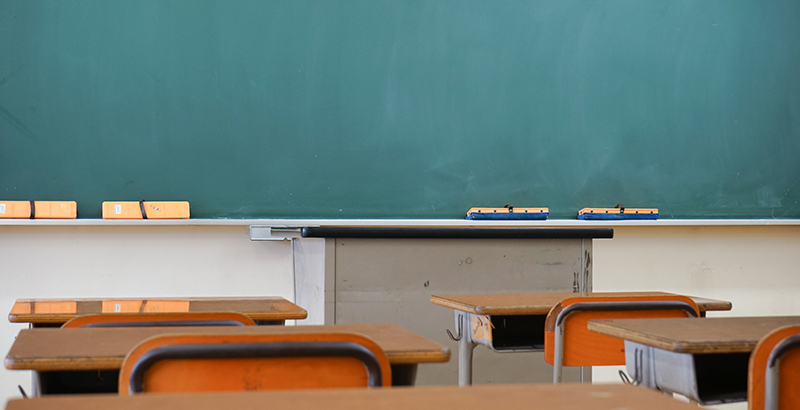Analysis: Why Are 27 Percent of District School Teachers Missing More Than 10 Days of School a Year?

According to the most recent data published by the Office for Civil Rights at the U.S. Department of Education, 27 percent of public school teachers are chronically absent — meaning they miss more than 10 days of school for illness or personal reasons. (The 74’s David Cantor offers a more thorough analysis of the data surrounding absences.)
That sounds like a lot. But is there an explanation for that number that might satisfy the many critics of our public school system? For example, might it be attributable to the fact that three-quarters of teachers are female, meaning they must deal with the physical stresses associated with maternity and (in most cases) the burden of being primary caregivers?
The short answer is no.
Obviously, teaching is a challenging occupation, especially in high-poverty schools. So the point of this column isn’t that teachers are slackers, or that they should never get a day off, or that no teacher should ever be chronically absent. The point is that there’s room for improvement.
Per OCR, public holidays, professional development days, and field trips don’t count as teacher absences. Nor do summer, winter, or spring break. But the data do include days missed for maternity and long-term illness, so let’s crunch the numbers for both those factors.
In 2016, approximately 6.2 percent of women ages 15 to 44 gave birth. Thus, since the median age of a teacher in the U.S. is 41 years old, back-of-the-envelope calculations suggest about 3.1 percent of female teachers gave birth that year (and about 3.1 percent of male teachers spent a lot more time changing diapers).
Although most teachers don’t get paid maternity leave, in most states, their paid sick leave carries over from one year to the next — often with no cap on the total number of days they can accumulate. If you believe that the first few months of life are critical to a child’s development, and that women need and deserve time off during those months, then teachers should take significant time off when they have a kid (so really, we should just give them maternity leave). In any event, it’s likely that most teachers who become new mothers are classified as chronically absent.
Of course, teachers are also likely to be chronically absent for other health-related reasons (e.g., cancer). Unlike the percentage of teachers who give birth, this figure is almost impossible to calculate from scratch. However, according to a recent analysis of data from the National Health Interview Survey, approximately 7.7 percent of U.S. workers with paid sick leave miss 10 or more days of work per year due to illness. Since the typical school year is about 20 percent to 25 percent shorter than the typical work year, we might expect that teachers would take fewer sick days than workers in other industries. However, since the typical elementary school is a hypochondriac’s nightmare, let’s assume they need as many sick days as workers in other industries.
Adding the illness-related chronic absenteeism rate for other industries to our estimate of teachers’ childbirth-related chronic absenteeism rate yields a projected teacher chronic absenteeism rate of 10.8 percent. That seems like a humane goal for the education system as a whole, although it fails to account for the shorter length of the typical school year.
Perhaps you think I’m missing something. (For example, perhaps you’re wondering whether teachers, because they are more likely to be primary caregivers, are more likely to miss work when one of their own children or a parent is sick.) So let me save time by conceding the point: It’s true that I can’t account for everything.
But here’s the thing: The teacher chronic absenteeism rate varies dramatically depending on which district or state you’re looking at. For example, the teacher chronic absenteeism rate is 16 percent in Utah and 75 percent in Hawaii. And the more you think about it, the tougher it is to see how interstate differences in long-term illness or teachers’ responsibilities as parents (or really, anything related to teachers’ demographic characteristics) could explain a difference of that magnitude. Furthermore, the variation in teacher chronic absenteeism is not well explained by student demographics. Nationally, teachers in schools with high concentrations of low-income and minority kids are only marginally more likely to be chronically absent.
Individually and collectively, these observations suggest that the key drivers of teacher chronic absenteeism have more to do with policy than personal circumstance. And indeed, that’s more or less what I find in a new report that documents the startling teacher chronic absenteeism gap between charter and traditional public schools, as well as the smaller (but still significant) gap between unionized and nonunionized charters. Nationally, brick-and-mortar charter schools have a teacher chronic absenteeism rate of 10.3 percent — strikingly similar to our projected rate — whereas traditional public schools have a teacher chronic absenteeism rate of 28.3 percent.
Some observers will argue that these patterns demonstrate the importance of protecting teachers from exploitation. But this is a tough case to make. For example, traditional public schools in San Francisco (which isn’t known for its abusive labor policies) have a teacher chronic absenteeism rate of just 10 percent.
So are all San Francisco teachers childless? Or, more plausibly, is it reasonable to expect a teacher chronic absenteeism rate of approximately 10 percent? And if 10 percent is good enough for teachers in San Francisco, why isn’t it good enough for teachers in the rest of America?
Get stories like these delivered straight to your inbox. Sign up for The 74 Newsletter

;)